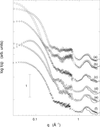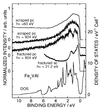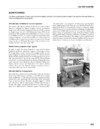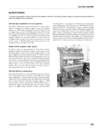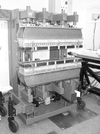issue contents
July 2002 issue

Cover illustration: The central plafond of Retaule del Conestable painted by Jaume Huguet (1414-1492) and kept in the Chapel of St Agata in Barcelona, indicating the position from which a sample was taken for analysis, see Salvadó, Pradell, Pantos, Papiz, Molera, Seco and Vendrell-Saz, pages 215-222.
facility information
lead articles
The synchrotron infrared beamline, U2B, dedicated to the biomedical and biological sciences, constructed and in operation at the National Synchrotron Light Source of Brookhaven National Laboratory, is reported.
research papers
A quantitative study of the radiation damage of protein crystals by an intense monochromatic X-ray beam from a third-generation synchrotron radiation source is described at cryogenic temperatures between 40 K and 150 K. It is confirmed that primary radiation damage is independent of temperature. However, at higher doses the quality of data acquired at 40 K is superior to those at 100 K, apparently due to the temperature dependence of secondary and tertiary radiation damage and to reduced thermal motion.
Wide-angle X-ray scattering data using a third-generation synchrotron radiation source provides characteristics of intramolecular structure and hierarchy of proteins in solutions with high statistics.
Multilayers of an Fe(II)-polyelectrolyte-amphiphile complex have been investigated simultaneously by energy-dispersive X-ray reflectivity and in-plane diffraction at the bending-magnet beamline at BESSY II.
Synergetics and respective advantages of nuclear resonant scattering of synchrotron radiation and of quasielastic neutron scattering are discussed on the basis of recent developments in the studies of diffusion in intermetallic alloys.
An application of synchrotron radiation X-ray diffraction mapping to the identification and distribution of green pigments in painting layers is described.
The surface profile of an Si flat substrate was retrieved from multiple total reflection images taken at various distances with coherent X-rays.
The X-dependent electronic structure of YbXCu4 (X = In, Cd, Mg) is discussed.
The present high-resolution photoelectron study of Heusler-type Fe2VAl confirms the predicted density of states, in particular, the existence of a pseudogap at EF in its bulk electronic structure, which may cause its semiconductor-like conductivity behaviour at high temperatures, and suggests its electronic structure is highly sensitive to the local structural modification.
High-resolution HeI photoemission spectroscopy, Mn 2p–3d resonant photoemission spectroscopy and Mn 2p X-ray absorption spectroscopy have been performed to investigate the electronic structure and its effect on the electrical resistivity in (La1−zNdz)0.46Sr0.54MnO3 (z = 0, 0,2, 0.6 and 1.0).
The temperature dependence of the ytterbium intermediate valence is measured in YbInCu4 and YbAgCu4 by resonant inelastic X-ray scattering, revealing in a bulk-sensitive way the characteristic Kondo temperature scaling.
A multi-element silicon drift detector was used for ex situ and time-resolved in situ fluorescence X-ray absorption spectroscopy on low-concentrated catalyst samples.
The design and performance of a bend-magnet beamline, for scanning transmission X-ray microscopy at the Advanced Light Source, is described.
The coherent diffraction from rectangular slits has been studied in detail in order to show that for micrometre-sized beams the X-ray diffraction from slits is a source of strong parasitic background, even for slits of high quality.
A simple scheme to suppress harmonic intensity of undulator radiation by undulator segmentation is presented.
The operation of an undulator which produces linearly polarized X-rays at various angles is described. Using the new technique, linear dichroism measurements of oriented polymer films are obtained on beamline 4.0.2 at the ALS.
current events
Free 

Free 

Free 



 journal menu
journal menu





















